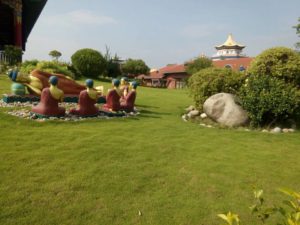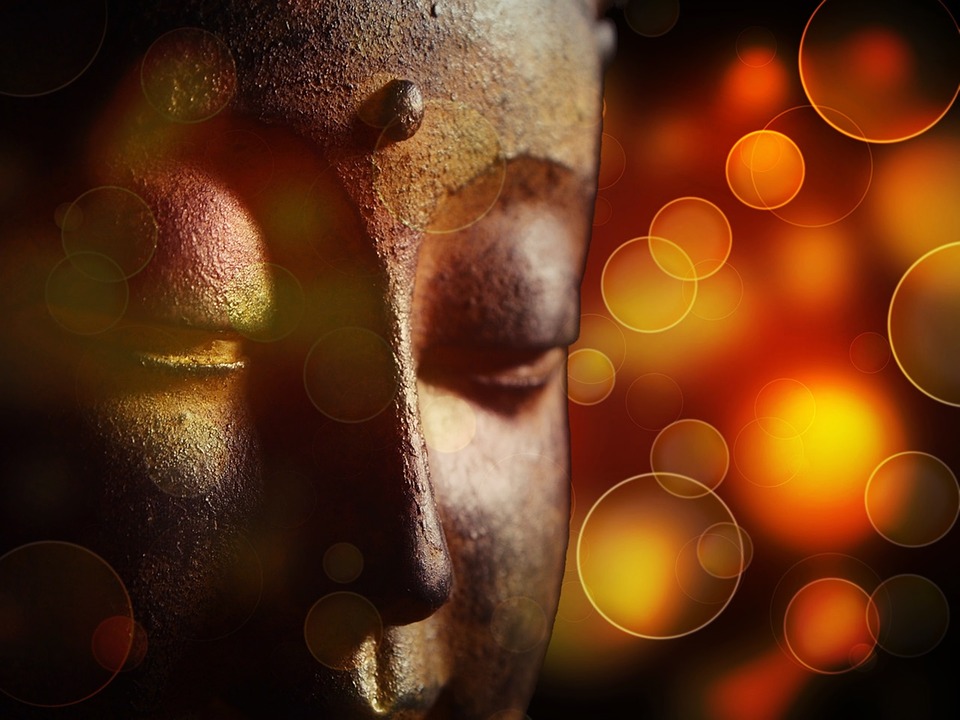The Buddha was born in roughly 560 BC in Northern India. The Buddha travelled the eastern world teaching about nirvana (the cessation of all suffering) and enlightenment the state he had achieved through meditation.
The Buddha was mythically born in unbelievable circumstances
Fathered by the king of the Shakaya clansmen Shuddhodana Gautama. His mother queen Maya dreamt of a white elephant coming down from the heavens and entering her body through her womb. The white elephant entering her womb was a sign that she was to give birth to a pure and powerful being. The myth that it came down from heaven was a sign that the child was from Tushita heaven.
 According to custom the queen had to go back to her parent’s home for the child’s birth so she set off to do so, on her way she took a rest in the beautiful Lumbini gardens. She reached out her hand to pluck a branch and as she did so the baby was born. Legend has it that when the child was born he walked seven steps while saying “AGGOHAM ASMI LOKASSA” meaning “Chief am I in this world“. The child was called Siddhartha. A hermit who noticed radiance about the castle then said this about him “This Prince, if he remains in the palace when grown-up will become a great king and subjugate the whole world. But if he forsakes the court life to embrace a religious life he will become a Buddha saviour of the world.”
According to custom the queen had to go back to her parent’s home for the child’s birth so she set off to do so, on her way she took a rest in the beautiful Lumbini gardens. She reached out her hand to pluck a branch and as she did so the baby was born. Legend has it that when the child was born he walked seven steps while saying “AGGOHAM ASMI LOKASSA” meaning “Chief am I in this world“. The child was called Siddhartha. A hermit who noticed radiance about the castle then said this about him “This Prince, if he remains in the palace when grown-up will become a great king and subjugate the whole world. But if he forsakes the court life to embrace a religious life he will become a Buddha saviour of the world.”
Siddhartha went out of the castle with his father
They were watching a farmer plough his field when Siddhartha noticed a bird fly down from the sky and fly away with a small worm, he then thought “Alas! Do all living creatures kill each other?” The prince was deeply impacted by this and as he grew older he began to think increasingly about the suffering in human life.
His father tried desperately to turn his mind to other things. The king arranged his marriage to Princess Yashodhara. Then he spent ten years on different pavilions for each season, being involved in joyful activities such as music and dancing, but his thoughts seemed to naturally deflect back to the problem of suffering in the world and trying to understand the real reason for existence.
He began to think about the luxuries of the palace and his rejoicing lifestyle he had always had a huge desire to go out and see the world, so he persuaded his friend the charioteer Channa, to take him out secretly to see the world, on his journey he saw four things an old man, a sick man and a corpse. When he saw the old man he asked his charioteer what it was, and he said “They are old Siddhartha, old age withers away life, it destroys memory, beauty and strength, it happens to us all”, this revelation really struck him as he had never come across this before. The next thing he saw was a sick man and questioned Channa further, the charioteer said: “no-one reaches the moment of death without falling sick at least once”. This was also a new revelation to Siddhartha. Finally, when he saw the corpse he said to Channa “what is death” Channa replied, “death comes to everyone in every family. When the body becomes old and stiff like wood, it has to be burned like wood”. These three sights really hit home and after seeing these he decided to find an answer to why life was this way.
Siddhartha decided to leave his wife and son
Siddhartha decided to leave his wife and son (which cannot possibly have been an easy decision) and set out as a holy man to try and find out the truth about life he began by joining a meditation school and there learned higher meditation, but eventually after surpassing his teachers decided that this was not the correct way to go about trying to obtain enlightenment. He then became an ascetic and rapidly became one of the greatest ascetics ever, legend has it that he was living on a grain of rice a day. He then was convinced that this too was not the correct way of going about this either despite having significantly strengthened his mind.
One day he overheard a musician teaching his pupils, telling them that “if you tighten the string too much it will snap, if you leave it too lose it will not play”. He realised the truth of this comment and quickly applied it to his life, he decided to follow a middle way, which would neither be too harsh on the body or to pleasurable.
He remembered back to a time in his childhood when he was sat under a tree watching his father perform a ploughing ceremony. He suddenly experienced a great sense of peace. He then decided that he would meditate so he sat down under a banyan tree and resolved not to move until he had obtained enlightenment.
All through the night he was tempted by demons but fought through all these temptations and when he eventually woke up he was fully enlightened and had achieved nirvana. From that point on he travelled the world teaching, and when he eventually died he was not reborn.
https://www.youtube.com/watch?v=EDgd8LT9AL4





